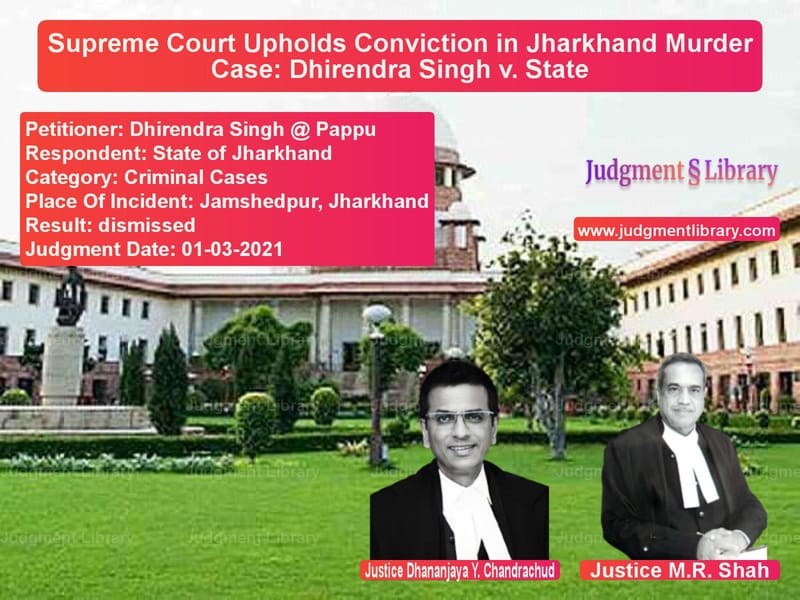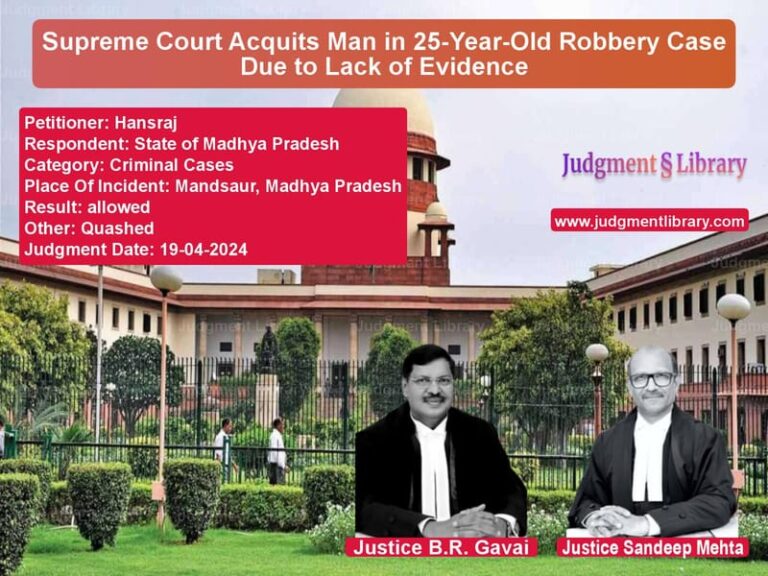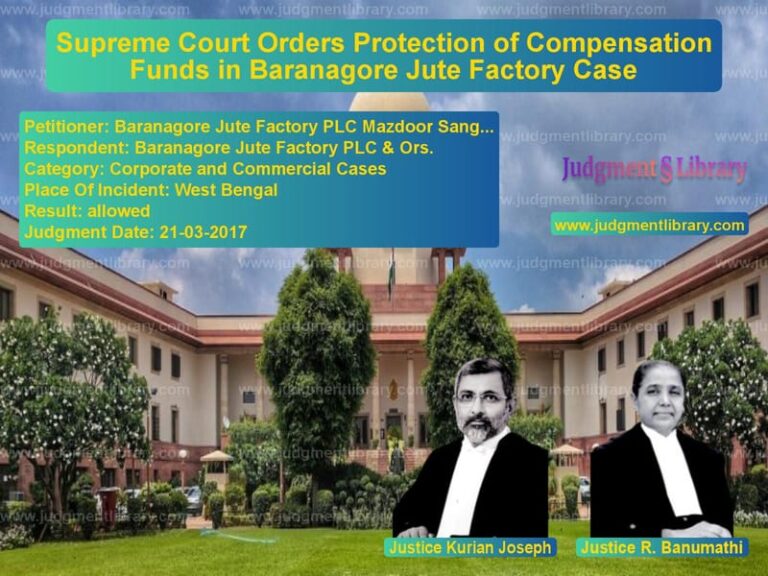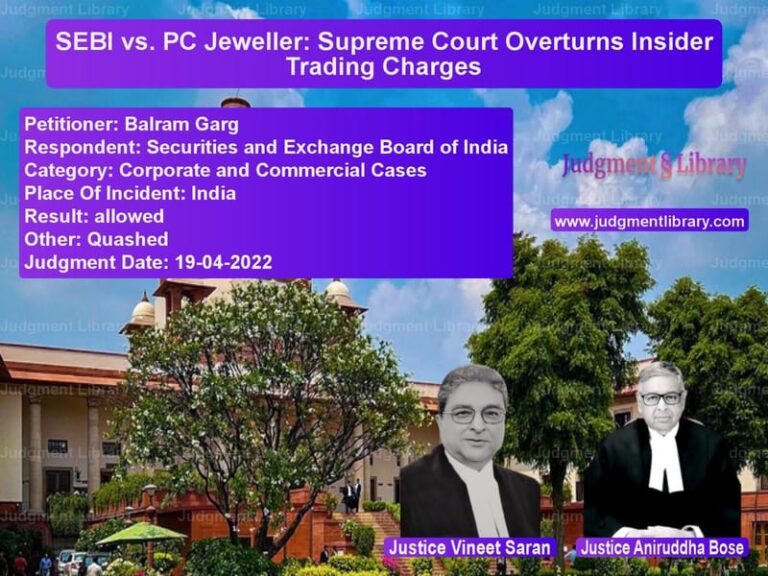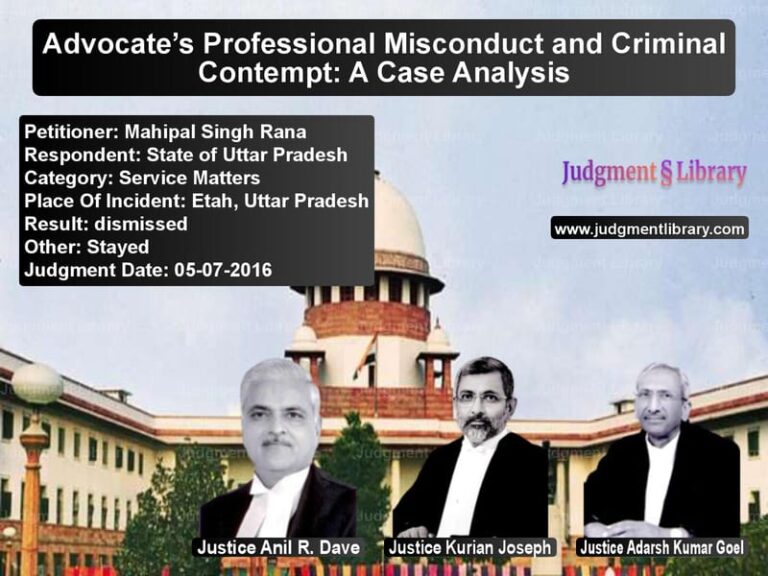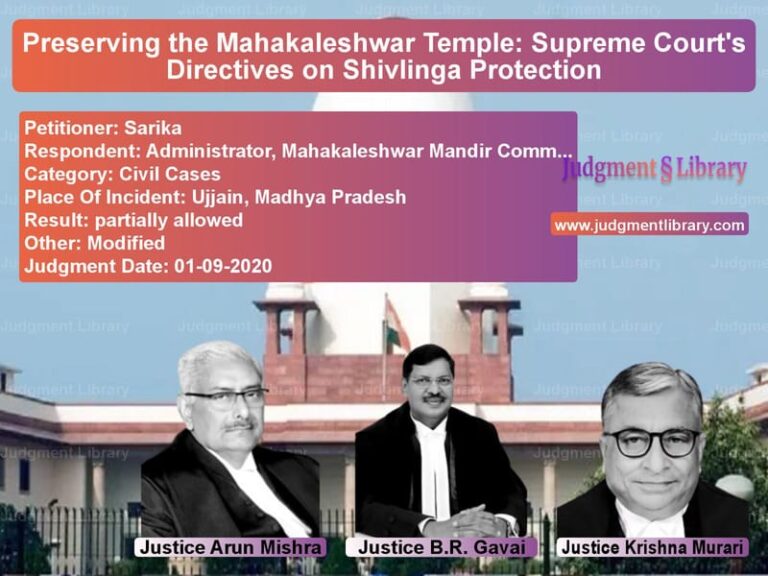Supreme Court Upholds Conviction in Jharkhand Murder Case: Dhirendra Singh v. State
The Supreme Court of India delivered a crucial judgment in the case of Dhirendra Singh @ Pappu v. State of Jharkhand, reaffirming the conviction of the appellant for murder under Section 302 read with Section 34 of the Indian Penal Code (IPC) and Section 27 of the Arms Act. This case is a significant example of how the Indian judiciary assesses witness credibility, evidentiary value, and procedural fairness in criminal trials.
Background of the Case
The case stemmed from the murder of Nirmal Mehto, which occurred on August 8, 1987. The prosecution alleged that the accused, along with co-conspirators, carried out the murder using firearms in Jamshedpur, Jharkhand. The primary evidence included eyewitness testimonies, forensic reports, and statements recorded immediately after the incident.
Read also: https://judgmentlibrary.com/supreme-court-allows-recall-of-witnesses-in-tamil-nadu-corruption-case/
Trial Court Proceedings
After years of investigation and legal proceedings, the Sessions Court convicted Dhirendra Singh for his role in the murder and sentenced him to life imprisonment. The key witnesses included the informant, Suraj Mandal, who was also injured in the incident. He provided a firsthand account of how the accused, along with his associates, fired shots at Nirmal Mehto, leading to his death.
Feeling aggrieved, Dhirendra Singh appealed to the High Court of Jharkhand, which upheld the conviction. Subsequently, the appellant moved the Supreme Court, challenging both the conviction and the sentence.
Petitioner’s Arguments (Dhirendra Singh)
The appellant raised multiple arguments, seeking to overturn his conviction:
- There were significant contradictions in the depositions of key witnesses, particularly P.W.7 (Md. Akhtar Hussain), P.W.8 (Nirmal Bhattacharya), and P.W.27 (Suraj Mandal), which raised doubts about his direct involvement.
- The prosecution failed to examine all five eyewitnesses, choosing to rely only on three, which undermined the reliability of the case.
- The firearm allegedly used by the accused was not recovered, weakening the prosecution’s claims.
- The accused had absconded for over 15 years before being arrested, but this alone should not have been used to infer guilt.
- The Fardbeyan (first information statement) was allegedly written by Suraj Mandal, despite him having sustained gunshot injuries on his hand, making it improbable that he could have written the statement.
Respondent’s Arguments (State of Jharkhand)
The prosecution countered these arguments, asserting:
- Despite minor contradictions in testimonies, all key witnesses confirmed the accused’s presence at the crime scene and his active participation in the murder.
- The victim’s injuries and the forensic findings corroborated the prosecution’s case.
- The absence of a weapon recovery did not dilute the overwhelming direct and circumstantial evidence against the accused.
- Eyewitness Suraj Mandal (P.W.27) was an injured witness, adding significant credibility to his statement.
- The accused’s prolonged absconding indicated a guilty conscience.
Supreme Court’s Observations
A bench comprising Justices Dr. Dhananjaya Y. Chandrachud and M.R. Shah analyzed the evidence and made the following key observations:
1. Credibility of the Eyewitnesses
“The presence of an injured eyewitness at the scene of the crime and his deposition in court is one of the strongest forms of evidence. There is no reason to doubt his testimony merely because of minor contradictions.”
The Court emphasized that minor inconsistencies in witness statements over time are natural and do not necessarily undermine the overall credibility of the prosecution’s case.
2. Legal Validity of the Fardbeyan
“The argument that the injured witness could not have written the Fardbeyan is speculative. The presence of medical reports confirming his injuries does not negate the possibility of his dictating or partially writing the statement.”
The Court dismissed the argument that the injured informant could not have recorded the Fardbeyan, noting that procedural lapses in documentation do not automatically invalidate the entire case.
3. Absconding as a Factor
“The conduct of an accused in absconding for 15 years must be considered in conjunction with other evidence. Flight from law enforcement is indicative of a guilty mind.”
The Court ruled that while absconding alone is not proof of guilt, it strengthens the prosecution’s case when combined with solid eyewitness testimony.
4. Conviction Under Section 302 IPC with Section 34 IPC
“The accused acted in concert with others to commit the crime, making him liable under Section 34 IPC for common intention.”
The Supreme Court upheld the view that the accused was part of a group that planned and executed the murder, justifying conviction under Section 302 read with Section 34 IPC.
Supreme Court’s Verdict
Based on these findings, the Supreme Court ruled:
- The conviction under Section 302 read with Section 34 IPC was upheld.
- The sentence of life imprisonment imposed by the trial court and affirmed by the High Court was confirmed.
- The absence of a recovered weapon did not diminish the accused’s liability.
- The appeal was dismissed in its entirety.
Impact of the Judgment
This ruling sets a precedent on several critical aspects of criminal law:
- Eyewitness testimony, especially from injured witnesses, carries significant evidentiary weight.
- Absconding for extended periods may strengthen the prosecution’s case.
- Minor contradictions in witness statements do not automatically lead to acquittal.
- Conviction under Section 34 IPC applies even if the specific role of each co-accused is unclear, as long as common intention is proven.
Conclusion
The Supreme Court’s ruling in this case reinforces the principle that courts must evaluate the credibility of eyewitness testimony with due diligence while ensuring that procedural flaws do not overshadow substantive justice. The judgment upholds the fairness of criminal trials and strengthens the legal framework for convicting individuals based on corroborative evidence and witness testimony.
Read also: https://judgmentlibrary.com/supreme-court-rejects-plea-of-juvenility-in-1982-murder-case/
Petitioner Name: Dhirendra Singh @ Pappu.Respondent Name: State of Jharkhand.Judgment By: Justice Dhananjaya Y. Chandrachud, Justice M.R. Shah.Place Of Incident: Jamshedpur, Jharkhand.Judgment Date: 01-03-2021.
Don’t miss out on the full details! Download the complete judgment in PDF format below and gain valuable insights instantly!
Download Judgment: dhirendra-singh-@-pa-vs-state-of-jharkhand-supreme-court-of-india-judgment-dated-01-03-2021.pdf
Directly Download Judgment: Directly download this Judgment
See all petitions in Murder Cases
See all petitions in Bail and Anticipatory Bail
See all petitions in Attempt to Murder Cases
See all petitions in Judgment by Dhananjaya Y Chandrachud
See all petitions in Judgment by Mukeshkumar Rasikbhai Shah
See all petitions in dismissed
See all petitions in supreme court of India judgments March 2021
See all petitions in 2021 judgments
See all posts in Criminal Cases Category
See all allowed petitions in Criminal Cases Category
See all Dismissed petitions in Criminal Cases Category
See all partially allowed petitions in Criminal Cases Category

